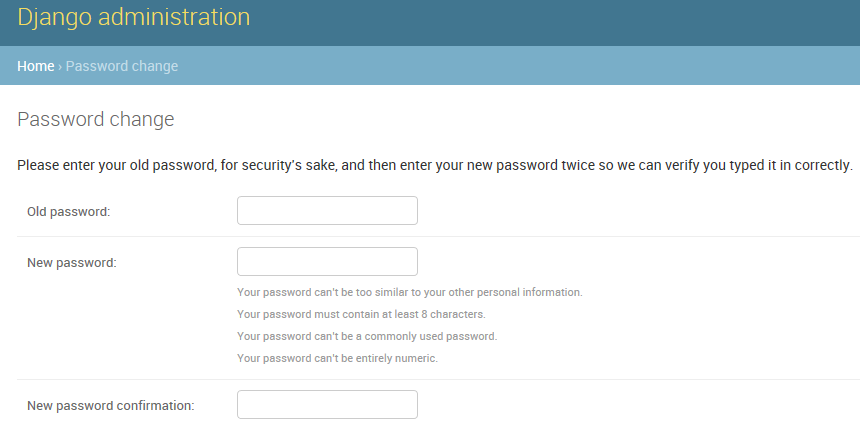Django之用户认证系统分析
Django自带一个用户认证系统,这个系统处理用户账户、组、权限和基于cookie的会话,下面将通过分析django源码的方式仔对该系统进行详细分析
1. 用户模型
在django.contrib.auth.models.py包中定义了class User(AbstractUser)类
(1)User模型字段
我在django中使用的是MySql,通过auth_user表查看User字段,当然大家也可以直接通过源码查看
def authenticate(request=None, **credentials): """ If the given credentials are valid, return a User object. """ for backend, backend_path in _get_backends(return_tuples=True): try: inspect.getcallargs(backend.authenticate, request, **credentials) except TypeError: # This backend doesn't accept these credentials as arguments. Try the next one. continue try: user = backend.authenticate(request, **credentials) except PermissionDenied: # This backend says to stop in our tracks - this user should not be allowed in at all. break if user is None: continue # Annotate the user object with the path of the backend. user.backend = backend_path return user # The credentials supplied are invalid to all backends, fire signal user_login_failed.send(sender=__name__, credentials=_clean_credentials(credentials), request=request)View Code
(3)login函数
login() 用于在视图中登录用户,它带有一个 HttpRequest 对象和一个 User 对象,并使用 Django 的会话框架在会话中保存用户 的 ID函数源码:
def login(request, user, backend=None):
"""
Persist a user id and a backend in the request. This way a user doesn't
have to reauthenticate on every request. Note that data set during
the anonymous session is retained when the user logs in.
"""
session_auth_hash = ''
if user is None:
user = request.user
if hasattr(user, 'get_session_auth_hash'):
session_auth_hash = user.get_session_auth_hash()
if SESSION_KEY in request.session:
if _get_user_session_key(request) != user.pk or (
session_auth_hash and
not constant_time_compare(request.session.get(HASH_SESSION_KEY, ''), session_auth_hash)):
# To avoid reusing another user's session, create a new, empty
# session if the existing session corresponds to a different
# authenticated user.
request.session.flush()
else:
request.session.cycle_key()
try:
backend = backend or user.backend
except AttributeError:
backends = _get_backends(return_tuples=True)
if len(backends) == 1:
_, backend = backends[0]
else:
raise ValueError(
'You have multiple authentication backends configured and '
'therefore must provide the `backend` argument or set the '
'`backend` attribute on the user.'
)
else:
if not isinstance(backend, str):
raise TypeError('backend must be a dotted import path string (got %r).' % backend)
request.session[SESSION_KEY] = user._meta.pk.value_to_string(user)
request.session[BACKEND_SESSION_KEY] = backend
request.session[HASH_SESSION_KEY] = session_auth_hash
if hasattr(request, 'user'):
request.user = user
rotate_token(request)
user_logged_in.send(sender=user.__class__, request=request, user=user)
login()
(4)authenticate和login函数使用示例
from django.contrib.auth import authenticate, login def my_view(request): username = request.POST['username'] password = request.POST['password'] user = authenticate(username=username, password=password) if user is not None: if user.is_active: login(request, user) # 重定向到一个登录成功页面。 else: # 返回一个“帐户已禁用”错误信息。 else: # 返回一个“非法用户名或密码”错误信息。
当你手动登录一个用户时, 必须 在调用 login() 之前调用 authenticate() 。在成功验证用户后,authenticate() 会在 User 上设置一个空属性,这个信息在以后登录过程中要用到。
3. 登录要求装饰器
(1)login_required函数原型
def login_required(function=None, redirect_field_name=REDIRECT_FIELD_NAME, login_url=None): """ Decorator for views that checks that the user is logged in, redirecting to the log-in page if necessary. """ actual_decorator = user_passes_test( lambda u: u.is_authenticated, login_url=login_url, redirect_field_name=redirect_field_name ) if function: return actual_decorator(function) return actual_decorator
(2)login_required()函数实现以下功能
(a)如果用户没有登录,那么就重定向到settings.LOGIN_URL,并且在查询字符串中传递当前绝对路径,例如:http://localhost:8000/account/login/?next=/blog/,/blog/为当前访问页面
(b)如果用户已经登录,则正常的执行视图,视图代码认为用户已经登录
(3)login_required()函数参数说明
(a)缺省情况下,成功登陆后重定向的路径是保存在next参数中,如果想换另外一个名称,可以使用第二个参数redirect_field_name,如果将redirect_field_name=‘nextlink’,之前的链接会变成http://localhost:8000/account/login/?nextlink=/blog/,注意,如果你提供了一个值给 redirect_field_name ,那么你最好也同样自定义 你的登录模板。因为保存重定向路径的模板环境变量会使用redirect_field_name 作为关键值,而不使用缺省的 "next"
(b)login_url参数,可选,默认为settings.LOGIN_URL
(4)示例
@login_required(redirect_field_name='nextlink')
def blog_title(request):
blogs = BlogModel.objects.all()
return render(request, 'titles.html', {'blogs':blogs})
4. 用户登出
在视图中可以使用 django.contrib.auth.logout() 来登出通过 django.contrib.auth.login() 登录的用户。它带有一个 HttpRequest 对象,没有返回值
from django.contrib.auth import logout
def logout_view(request):
logout(request)
return redirect('/account/login/') #重定向到另一页面
当调用 logout() 时,当前请求的会话数据会清空。 这是为了防止另一个用户使用同一个浏览器登录时会使用到前一个用户的会话数据。 如果要在用户登出后在会话中储存一些数据,那么得在 django.contrib.auth.logout() 之后储存。注意当用户没有登录时,调用 logout() 函数不会引发任何错误。
5. 修改密码
(1)django提供了python manage.py changepassword *username* 命令修改用户密码,如果给定了用户名,这个命令会提示你输入两次密码。 当两次输入的密码相同时,该用户的新密码会立即生效。如果没有给定用户,这个命令会 尝试改变与当前用户名匹配的用户的密码
(2)使用set_password() 方法和 check_password() 函数用于设置和检查密码,函数位于django.contrib.auth.base_user.py包中
from django.contrib.auth.models import User
u = User.objects.get(username='john')
u.set_password('new password')
u.save()
(3)Django提供了PasswordChangeView类实现重置密码,类位于django.contrib.auth.views包中
下面演示如何使用PasswordChangeView类重置密码:
a. 设置URL
from django.conf.urls import url from django.contrib.auth import views as auth_views urlpatterns = [ url(r'password_change/', auth_views.PasswordChangeView.as_view(), name='password_change'), url(r'password_change/done/', auth_views.PasswordChangeDoneView.as_view(), name='password_change_done'), ]
b. 设置LOGIN_URL = '/account/login/',若不设置会使用global_settings.py中设置的LOGIN_URL = '/accounts/login/'
c. 测试,由于我使用的当前应用为account,启动浏览器输入localhost:8000/account/password_change/由于未登录,会转换到登录界面,会变成登录链接http://localhost:8000/account/login/?next=/account/password_change/

登录后,再重置密码http://localhost:8000/account/password_change/

参考博客:http://blog.chinaunix.net/uid-21633169-id-4352928.html
- Django用户认证系统 authentication system----登陆访问限制@login_required
- Django1.5内置的用户认证系统介绍(之四)Authentication in Web requests --by hillfree
- Django1.5内置的用户认证系统介绍(之五)在admin后台管理用户 --by hillfree
- Django1.5内置的用户认证系统介绍(之一)--by hillfree
- Django用户认证系统(一)User对象
- 14:django 用户认证系统
- Django用户认证系统 authentication system
- Django用户认证系统(二)Web请求中的认证
- 基于Django用户认证系统详解
- Django用户认证系统(三)组与权限
- Django1.5内置的用户认证系统介绍(之二)使用User对象--by hillfree
- Django自定义用户认证系统Customizing authentication
- Django用户认证系统(二)Web请求中的认证
- 转载django 用户认证系统
- Django1.5内置的用户认证系统介绍(之三)权限与授权--by hillfree
- Django用户认证系统(三)组与权限
- Django用户认证系统(三)组与权限
- django 用户认证系统
- django 用户认证系统 相关资料
- Django权限系统auth模块详解 转自:原文出处 auth模块是Django提供的标准权限管理系统,可以提供用户身份认证, 用户组和权限管理。 auth可以和admin模块配合使用, 快速建
